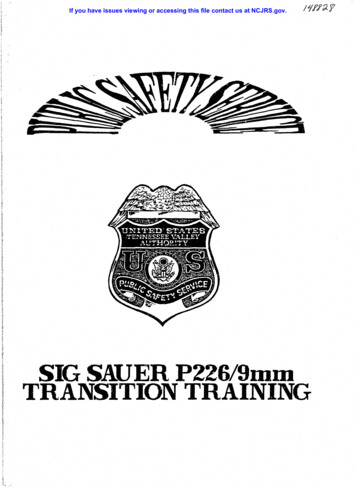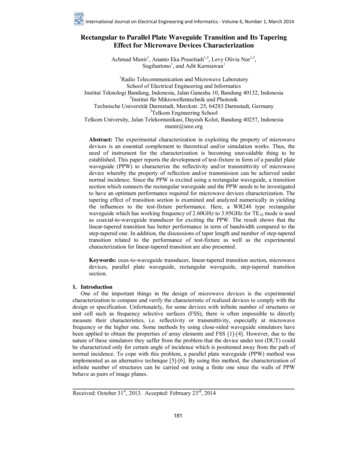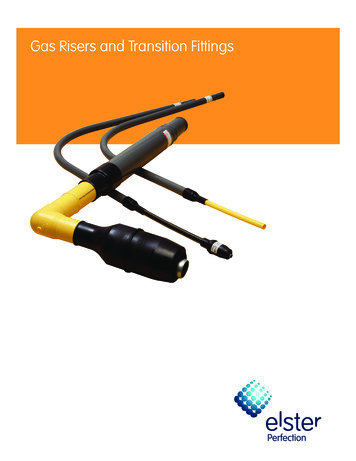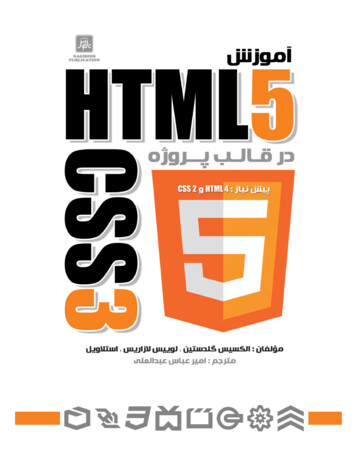
Transcription
If you have issues viewing or accessing this file contact us at NCJRS.gov.!, J 'c r , ,jf,",,,\i, .'SIGSAUER P226/9mmTRANSITION TRAINING
- -, -SIG SAUER P226/9m.mTRANSITION TRAINING
148828U.S. Department of JusticeNational Institute of JusticeThis document has been reproduced exactly as received from theperson or organization originating It. Points of view oroplnlons stated inthis document are those of the authors and do not necessarily representthe official position or policies of the National Institute of Justice.Permission to reproduce this copyrighted material has beengr iihessee Valley Authorityto the National Criminal Justice Reference Service (NCJRS).Further reproduction outside of the NCJRS system requires permissionof the copyright owner.1111111
eeSTAGEROUNDSDISTANCE AND TIMENameSTAGElADateTimeNOTE: Transtar II targets will be used.70% is i'Cquired to qualify.Instructor's SignatureeFIREARMS QUALIFICATION FORM9mm SIG SAUERSTAGEIBTimeSTAGE2ATimeFAGE .ST.AGE2 B , ,ATimeTimeSTA. GE4A,TimeSTAGE4B,Time. \ . ,., . . . 'I\1' , 0 1 ' " A L S ,. ' .p :esI",-S!"0' :.I.1 2 I 3 I 4 I 5 I RE I lA 6 RDS (3) yard line - 1 RD ill 2 sec. from holster - strong hand only.1B 6 RDS (2) RDS 3 sec. from holster, two hand point shoulder. Stay combat ready - remaining (4) RDS - 2 RDS 2 sec.2A 12 RDS (7) yard line - 1 RD 3 sec. tactical reload (two hands from holster transfer weak hand - 15 sec - remain aimed in 1 RD/3sec.2B 12 RDS - (2) RDS 4 sec., two handed from holster, last (2) RDS emergency reload - 2 RDS/I5 sec., decock (2) RDS 4 sec. (stronghand only).3A 12 RDS (15) yard line - 3 RDS 7 sec. right standing barricade. Kneel remained in 3 RDS magazine exchange, 3 RDS left standingbarricade 20 sec. kneel 3 RDS/6 sec.4A 6 RDS right side barricade 3 RDS/8 sec - 2 RDS/5 sec - 1 RD 3 sec.4B 6 RDS left side barricade 3 RDS/8 sec - 2 RDS/5 sel,; - 1 RDS/3 sec.
eeeTVA PUBLIC SAFETY.PRACTICAL PISTOLCOURSE FOR SSROTSTIMEDESCRIPTION3 YARDSlASTANDING2 MAGS W\6 RDS6 RDS12 SEC.ONE ROUND IN 2 SECONDS,POINT SHOULDER SHOOTINGw\sTRONG HAND ONLY. DRAWFROM HOLSTER, REFERENCESIGHTS, FIRE ONE ROUND FOREACH SOUND OF THE HORN.AFTER LAST HORN, EXECUTEAN EMERGENCY RELOADAND COVER THE TARGETHOLSTER A IJOADED NIBSTANDING(2 ND MAG)ROUNDS6SHOTS3 YARD23 SEC.AND2 SEC.TWO ROUNDS IN 3 SECONDS,POINT SHOULDER, TWO HANDEDDRAW FROM THE HOLSTER ANDSHOOTER WILL Nir".1NTAIN ACOMBAT READY POSmONWITH WEAPON SLIGHTLY BELOWEYE LEVEL. ON NEXT SOUNDOF HORN SHOOTER BRINGSWEAPON UP TO EYE LEVEL ANDFIRES TWO ROUNDS IN 2SECONDS. HOLSTER ANUNLOADED WEAPON.NOTE: FOR SEMIAUTOMATICS WITH DECOCKING I SAFETY LEVERS . SfiOOrERS WILL NOTDECOCK BETWEEN SHOTS. SHOOTER'S WILL REMOVE FINGER FROM TRIGGER BETWEEN SHOTAT COMPAT READY. WHEN FIRING SINGLE ACTION (SA) SHOOTER'S WILL SCAN TARGET A."'U:ABEFORE HOLSTERING
eeDISTANCESTAGE7 DSSHOTSTIME1213 SEC.DESCRIPTIONONE ROUND IN 3 SECONDS,POINT SHOULDER, TOW HANDEDWITH SIGHTS, DRAWING FROMTHE HOLSTER. AFTER SIXTHROUND IS FIRED, EXCUTE ATACTICAL RELOAD TRANSFERWEAPON TO TIlE WEAK HANDROUND ONLY AND FIREONE (1) ADDITIONALIN 15 SECONDS AT TIlESOUND OF TIlE HORN, UNTILCOMPLETION OF THE STAGEOF FIRE. HOLSTER ANUNLOADED WEAPON.NOTE: When using the weak hand the shooter's stance will not change. The. shooter's strong hand should remainat the sideSHOOTERS WILL NOT DECOCK USING THE WEAK HAND ONLY.The shooter should be reminded that when the tactical reload is accomplished correctly, one round should remain in thechamber and MUST be properly cleared before holstering.DISTANCE7 ME2 mags w/6 rds1224 SEC/DESCRIPTIONTWO ROUNDS IN 4 SECONDS,POINT SHOULDER, TWO HANDEDWITH SIGHTS, DRAWING FROMTHE HOLSTER AFTER TIlE 5THAND SIXTH RDS. EXECUTE AEMERGERNCY RELOAD ANDFIRE TIlE 7TH AND 8TH ROUNDSIN 15 SECONDS. SHOOTER TIIENDECOCK (IF NECESSARY) ANDDROP THE WEAK HAND.SHOOTER TIIEN FIRES (2) RDS.IN 4 SEC., STRONG HANDFROM TIlE AIMED IN POSmON,UNTIL COMPLETION OF THE STAGEHOLSTER AN UNLOADED WEAPON.NOTE: When using the strong hand, the shooters stan;:e should NOT change.The shooters weak hand should remain at the side. DO NOT decock when using the strong hand only
eee DISTANCE15 YARDSSTAGE3POSITIONMAGAZINESRIGHT/LEFT1 MAG WI7 RDS.1 MAG W/5 RDS.SIDE STANDIINGIKNEELINGBARRICAL)EROUNDSSHOTS123TIME7 SEC.6 SEC.DESCRIPTIONDRAW AND FIRE THREE ROillil)SIN 7 SEC., RIGHT SIDE STANDINGBARRICADE. AT THE SOUND OFHORN THE SHOOTER WILLMOVE TO THE RIGHT SIDEKNEELlNG BARRICADE ANDREMAlNG AIMED IN. NEXTSOUND ON THE HORN THESHOOTER WILL FIRE THREEROUNDS FROM THE AIMED INPOSmON EXECUTE A MAGAZINEEXCHANGE THEN MOVE TO THELEFT SIDE STANDlNGPOSmON AND FIRE THREE MOREROUNDS ALL WIIH IN 20 SEC.THESHOOTER LTHENMOVE TO THE LEFT SIDEKNEELING BARRICADE ANDREMAlN AIMED IN. AT THESOUND OF THE HORN SHOOTERWILL FIRE THE FINAL THREEROUNDS IN6 SECONDS. THESHOOTER WILL THEN SCANTHE AREA TO BE CERTAlN IT ISSAFE, COhlJ)UCT A CLEARINGPROCEDURE, CHECK IT TWICEAND HOLSTER AN UNLOADEDWEAPON.NOTE: When the shooter is aimed in on a target, the finger will be ON THE TRIGGER, when firing double aciton (DA).When changing positions behind the barricade, the weapon is DECOCKED, finger OFF the nigger.
DISTANCE25 YARDSDISTANCE25 YARDSSTAGE4ASTAGE4BPOSITIONMAGAZINESright sideStandingBarricade1 mag w/l2 rds6(or 2 mags/w 6 Rds.)POSITIONLeft TIME25 sec.13 sec.SHOTS38 sec.25 sec.13 SEC.8 sec.TIMEDESCRIPTIONSHOOTER WILL DRAW AND FIRE 3ROUNDS IN 8 SECONDS. SHOOTERWILL REMAIN AIMED IN. AT THESOUND OF THE HORN THESHOOTER WILL FIRE 2 ROUNDS INFIVE SECONDS. AT THE SOUND OFTHE HORN FIRE ONE ROUND IN3 SECONDS. PREPAREFORSTANDJNG LEFT SIDE BARRICADEPOSTION. hOLSTER A LOADEDWEAPON.DESCRIPTIONSHOOTER WILL FIRE THE SAMESEQUENCE AS RIGHT SIDEBARRICADE ABOVE,THEN CLEAR, CHECK IT TWICEAND HOLSTER AN EMPTY WEAPONNOTE IN COMBAT SITUATIONS (AmiED IN) THE FINGER REMAINS ON THE TRIGGER WHEN FIRING DOUBLE ACTION (DA), ANDOFF THE TRIGGER WHEN FIRING SINGl.E ACTION (SA).MARKSMANSHIP RATINGSTOTAL ROUNDSPOSSIBLE SCOREMINIMUM SCORE60300210210 - 254 MARKSMAN255 - 284 SHARPSHOOTER285· 299 EXPERT300 DISTINGUISHED EXPERT
SIG SAUER P226/9mmTRANSITION TRAINING
INTRODUCTION'The Training Division would like to welcome you to the TennesseeValley Authority (TVA), Public Safety Service (PSS) semi-automaticpistol transition program. The curriculum provides the necessarytraining for in-service firearms instructors to transition ourpersonnel from the revolver to the semi-automatic pistol.Introduced to PSS in April 1994, this program was developed to addressthe growing trend of conversion to semi-automatic pistols by lawenforcement personnel. This program is adopted by the PSS from the Federal Law EnforcementTraining Center (FLETC) and will become an official "Practical PistolCourse" for the semi-automatic pistol. This training utilizeslecture, demonstration, two graded practical exercises, and a writtenexamination. There will be no remedial training given for the writtenexamination .
TABLE OF CONTENTSIntroduction:Section 1.1.2. 3.4.5.6.7.Safety(Tab B)Firing Range and Safety RulesSyllabus 9n Transition - Firearms SafetySafaty HandoutSection III1.2.(Tab A)SIGARMS WarningThree-day Transition Schedule for SIG-Sauer P226Section II.1.2.3.TransitionFLETC Text(Tab C)SIG-Sauer 9rnm Semi-automatic (Handout)Immediate Action for Semi-nutomatic PistolsIncluding 1Norksheet (Handout)Fundamentals of Marksmanship for Semi-automatic Pistols (Handout)Reduced Light for Semi-automatic Pistol (Handout)SIG Pistol Familiarization Courses I-VII PracticeFLETC PPC Qualification for Semi-automatic Syllabus Outline of Instruction FLETC Prnctical Pistol Course for the Semi-automatic PistolP226 Functional Performance Test (Class Room Pass Fail)Section IV.Test(Instructor Will Haintain Security On Test)Record of Update and ReviewAuthority 1947N(Tab D)
SECTION I TAB ATRANSITION
." ." ." ." * * S/GARMSWARNING'" * * . *All owners and users of SIG Sauer pistols arereminded to use the decocking lever to decock their pistols.This is the only way to safely lower the hammer from thecocked position and prevent an accidental dischargecaused by thumb-slipping or dropping the pistol.This Warning applies to all pistols with decockinglevers *. The only positive way to safely lower the hammeris by use of the decocking lever.Hammers should. never be lowered by manuallylowering the hammer by pulling the trigger. Manuallylowering the hammer is dangerous in itself and prevents thefull application of the pistol's safety features.The decocking lever is the only proper method oflowering the hammer and assuring that the hammer restsin the Intercept notch. The Intercept notch prevents thehammer from striking the firing pin, whether from slippingmanually, or accidentally dropping the pistol.DO NOT thumb the hammer down: the consequencecan be serious injury or death only and ALWAYS usethe decocking leverl ***********P220P225P226 . .\ SEE THE OWNER'SMANUAL FOR FIREARMSSAFETY INSTRUCTIONSP228P229P230.r.'".,.":'
SIG SAUER P226 TRANSITIONDAY 1INTRODUCTIONSAFETY NOMENCLATURE/CLEANINGCYCLE OF OPERATION/LOADING/UNLOADINGFUNDAMENTALSIMMEDIATE ACTION DRILLS/MALFUNCTIONSCOURSE OF FIRE
- DAY 2QUESTIONS FROM PREVIOUE. DAYSAFETYIMMEDIATE ACTION DRILLSMAGAZINE EXCHANGE FIELD STRIPPING WEAPONCOURSE OF FIRE FOR DAYDIM LIGHT FIRE --- ---------
--------------- ---DAY 3QUESTION FROM PREVIOUS DAYSAFETYPRACT!CE QUALIFICATION QUALIFICATIONTACTICAL COURSE---
SECTION II TAB BS/ !.FETY I
TENNESSEE VALLEY AUTHORITYPUBLIC SAFETY SERVICEFIREARMS SAFETY RULESA. GENERAL RULES: l. Treat all firearms as if they are loaded.2. Never point a firearm at anyone unless you are justified in shooting that person.3. When a firearm is picked up, immediately open the cylinder or action to determinewhether it is unloaded.4. Never give a firearm to or take a firearm from anyone unless the cylinder or actionIS open.5. Be sure there is no obstruction in the barrel of the firearm before loading.6. Never draw a firearm from the holster or reholster with the finger in the triggerguard.7. Never pennit the muzzle of a firearm to touch the ground.8. Never let the hammer of a revolver down on a live cartridge without first placingthe thumb in front of the hammer .9. Never fire a succeeding shot after a malfunction without first unloading andchecking the barrel for obstructions.B. SPECIFIC RANGE RULES: 1. Eye and ear protection will be worn at all times while on the range.2. No loaded weapons are allowed on the range except on the firing line.3 . Weapons must remain holstered until the user reaches the firing line. If a weapon isto be carried on the range, the cylinder must be open or slide locked open, with themagazine out.4. Do not load until the command is given. NEVER anticipate a command.5. Fingers are not to be placed within the trigger guard until pointing the weapon atthe target. This is especially important when drawing the weapon from the holster.6. Weapon muzzles will be pointed down range at all times when not holstered.NEVER point over the top of the backstop.7. Talking is not allowed 8;t the firing line or to the shooter on the firing line exceptby instructors.8. Smoking, eating, or drinking on the firing line is prohibited.9. In case of a misfire or squib, keep the fireann pointed down range a least 10seconds before opening the cylinder or slide.10 . If a weapon is accidentally dropped, immediately inspect the weapon to ensure thatit can function.11. Dry firing behind the firing line is prohibited.
-2-Fireanns Safety Rules (Continued)12.13.14.16.Do not handle a weapon on the firing line when there is someone downrange.Never leave the firing line without unloading and holstering the fireann.Shout "CEASE FIRE" any time an unsafe act is observed that endangers someone.Any injury sustained on the range, regardless of how minor it may seem, must bereported to the Public Safety Officer on duty.17. Strict discipline will be maintained. Carelessness cannot and will not be toleratedon the range.
US*TVA PUBLIC SAFETY SERVICE9MM PISTOL TRANSITIONFIREARMS SAFETYDESCRIPTION:Through lecture, demonstration, and class discussion, this course applies to, nomenclature as itpertains to safety, safety rules and regulations, safe weapons handling, decocking, loading, unloading,and transfer of a weapon from one person to another. Students will be able to safely handle andoperate the weapon.TERMINAL PERFORMANCE OBJECTIVES: Given a written multiple choice examination and/or a weapon, the student will identify/demonstratehow to safely handle, decock, load, unload, and transfer a weapon from one person to another safely.The student must demonstrate safe operation of the weapon.INTERIM PERFORMANCE OBJECTIVES:1.2.3.4.5.6.Demonstrate/identify weapon nomenclature pertaining to safetyDemonstrate/defme safety rules and regulations.Demonstrate/describe safe decocking procedure.Demonstrate/describe safe loading and unloading procedures.Demonstrate/describe safe transfer of weapon from one person to another.Demonstrate/describe proper grip and safe operation of the weapon.METHOD OF EVALUATION:1.2.Instructor observation.Written examination.METHODOLOGY:1.2.3. Lecture/discussionDemonstration.Hands on practical.
2 REFERENCES:1.Instructor. FLETC Safety Rules & Regulations / General Range Information Supplement Handout6001H. FLETC Firearms Safety Rules & Regulations 6001. TV A Public Safety Service Range Safety Rules. TV A Public Safety Service Firearms Safety Rules & Regulations.2.Student:TVA Public Safety Service Range Safety Rules. TVA Public Safety Service Firearms Safety Rules & Regulations. Safe Attitude handout.oTRAINING AIDS: 1.Instructor: 9MM Sig Saurer Pistol.eAppropriate leather gear. Eye and ear protection. Dummy ammunition.2.Student: 9MM Sig Sauer Pistol.Appropriate leather gear.
SAFETY HANDOUTIlSAFETY IS AN A TTl TUDE"ON LINE SAFETY - THREE GOLDEN RULESI.WHEN DIRECTED TO STEP TO THE LINE, DO SO AND REMAIN THERE.Allstart and stop on the firing line.BEGIN - "With eye and ear protection on."END "Place feet on the firing line withhands behind your back." command II.NEVER BEND OVER ON THE LINE UNLESS PERMISSION IS GIVEN.III.NEVER LOOK BEHIND YOU ON THE FIRING LINE. THE ONLYEXCEPTION, IS WHEN YOU ARE RUN ING A TACTICAL COURSE.
3 INTRODUCTION:I.2.3.4.This course is designed to develop officers into safe and competent pistol handlers. Safety isfirst and foremost, and is never compromised.Accidents do not just happen, people cause them; usually through carelessness and failure touse good common sense. Stay alert and obey all range commands and procedures.As with any Public Safety firearms qualification or training, safety violations will beaddressed immediately.Refer to safety handouts,NOMENCLATURE PERTAINING TO SAFETY:I.2.3.4.5. Muzzel; always pointed in a safe direction.Trigger; finger out of the trigger guard until ready to fire the weapon.Decock lever; (demo).Magazine Release; drops magazine out of weapon,Slide Stop; holds slide to the rear.Automatic Firing Pin Lock; will not allow pistol to fire without squeezing trigger,WEAPON SAFETY FEATURES:I.DISCONNECTOR;This prevents the weapon from firing unless the slide is fully closed, and the weapon is fullycocked. It also prevents the weapon from firing fully auto.2.FIRING PIN SAFETY LOCKThis provides optimal safety with the hammer in either the cocked or decocted position. Theweapon can only be fired by pulling the trigger. .3.SAFETY INTERCEPT NOTCHThis catches the hammer after the decocting has been released. During and after decocking,the firing pin remains constantly locked. It also prevents discharge of a chambered roundshould the weapon oe dropped, much like the hammer block of a revolver 4.DECOCKING LEVERThis feature drops the hammer into the Safety Intercept Notch locking the firing pin notpermitting it to strike the primer.5.SLIDE STOPThis feature holds the slide to the rear disabling the weapon.
4 SAFETY RULES AND REGULATIONS:1.2.Review TV A Public Safety Service Firearms Safety Rules.Review TVA Public Safety Service Range Rules.LOADING/UNLOADING PROCEDURE: I.LOADING:.Keep muzzel pointed in a safe direction.Finger OFF the trigger.With the slide forward, insert the magazine and make sure it has engaged themagazine catch. Tug on the base of the magazine floor plate to ensure properseating. Draw the slide back and allow it to snap forward into battery. ( Do not ride the slideforward). Thumb the decock lever and allow the hammer to fall. The weapon is now ready to fire in the double action mode.2.UNLOADING: Keep the muzzel pointed in a safe direction. Finger OFF the trigger.Push the magazine release and remove the magazine. Draw the slide back and lock it to the rear. Visually and physically inspect the chamber and magazine well to ensure there areno rounds in the weapon. Reh ase the slide and allow it to go forward. Decock the weapon with the decockleVf:r and secure the weapon.DECOC[{ING!I.2.3.4.Point the weapon in a safe directionFinger QFF the trigger.Locate the de cock lever on the side of the weapon.Right-handed people place the weak thumb on the decock lever and press down. The hammerwill fall safely, rendering the weapon into a double-action mode. Left-handed shooter will usestrong hand index finger to decock.REVIEW UNSAFE ACTS: 1.2.3.4.S.Turning around with weapon in hand.Handling a weapon when people are down range.Drawing weapon with finger on trigger.Bending over on the line.Not following commands.
---------- SECTION III TAB CFLETC Text
SIG-Sauer 9mmSEMI-AUTOMATIC (Handout)
DEPARTMENT OF THE TREASURY FEDERAL LAW ENFORCEMENT TRAINING CENTEROFFICE OFSPECIAL TRAININGFIREARMS DIVISION SIG SAUER 9mm SEMI-AUTOMATICHANDOUT 6023 H1/92
SlG8AlJER(P226)INTRODUCTIONThe followinginformation concerning the SIG SAUER P226 wascompi led for you convenience and is intended only as supplement topractical instruction.Designed by the Swiss and manufactured in West Germany, the P226combines the- latest in engineering and technologicalcountries.By entering dvnncesof bothinto collaboraUon with one another, SIG(Swiss Industrial Group) located in Neuhausen, Switzerland, and J.P.SAUER and SON loca-ted in Eckernforde, West Germany, were able to aid each other in the production of world class handguns.The SIG SAUERP226 pistol has been specifically designed to meet the requirementsof both mi I Itary and civi I ian law enforcement.
'SPEC I F I CAT IONSMODEL: .co It P226BARREL:Six 9 roo v e s. r i l h thand tV! i s nneturn in ten inchesICAL I BER :. . .OVERALL LENGTH: .9rrm7.7 11VIE I GHT I NCLUD I NG EMPTY32 ozs.MAGAZINE: . IWITHOUT MAGAZINE:. MAGAZINE:Tr.IGGER PUL.L,D/A . . .S/A .29.8 OZS.SIGHTS:HE r GHT:WIDTH: . . 5 .5 11. . . . . . . . . . .1 .51/ BARREL LENGTH: . .4.41/15round cap'aci,ty13 Ibs.4.5 Ibs.Semi-PatridgeWindage adjustablewith drift tool 2
SAFETY FEATURES)There is no independent manuill sa rety, however, there is arassive safety system operating at at I tlm s.Incorporated in thi 'system include: Disconncctcr, Firing Pin Safety Lock, Safety Intercept Notch and Decocking Lever.DISCONNECTOR - Prevents the weapon from firing unless it is closedand fully locked.It Cll50 prevents the weapon fromfiring fully automatic.FIRING PINSAFETY LOCK -Prov i des optima I sa fe ty with the harrrne r in either thecocked or decocked position.The weapon can only befired by pul ling the trigger.SAFETYINTERCEPTr OTCH' -'Catches the hammer after the decocking lever has beenreleased.During and after decockin9, the firing pinremains constantly lockeri.The Safety Intercept Notchalso becomes effective in the case of inadvertentharrrner tripping when thumb cocking the weapon.Italso prevents discharge of a chambered round shouldthe weapon be dropped.DECOCKINGLEVER '-----Drops thr. hammer into the Safety Intercept Notchlocking the (iring pin.3
LOADING PROCEDURES1.'Insert magazinefullyinto the magazine wellwiththe weaponpointed in a safe direction.NOTE:trigg rTrigger finger should be outside of the2.Give magazine a tug to check for proper seating.3.To chamber a roun'd,let the sl ide go forward.a! ready forward, draw back the's I i de to theI f the s I i ge Istop and a I low it toThumb down the decocking IGver.' The weapon is now loaded, safeand ready to fire.S.guard.Do not ride th sl ide home.snap forward.4.5 (Inthe!doublc acti n mod )First round is fired double action, with each additionalfiringsingle action.CYCLE OF ing,Extracti,ng,Ejecting and Cocking.CLEAR I NG THE WEAPON1.Always remove the magazine first.2.Push up on the sl ide ca,tch lever keeping the muzzle away from you in a safe direction.3.Grasp the s I ide by the grasping grooves and pullthe rear.lj toRound should exit the weapon if chambered.L00 kin sid e the c h a mb e r t 0sure.the s I ideIf itis dark, usc the small5.Let the sl ide go forward.6.Thumbdownins lJ rei t i s c I ear .thedecock I ngI ever.L0 0 k t w icc t 0 befinger to check the chamber.P,istolisnowunloaded,decocked and safe.NOTE:There is no reason to go near the trigger while clearingthis weapon.4
MALFUNCTIONSIn the event of a malfunction,one can usually remedy thesituation by remembering the word SSPORTS and fol lowing its principies.the trigger again.1. queeze2. Iap3.Pull backonthesiide.4.Obs e rve chambe r fo r stoppage.5.Release 51 ide.6.!ap sl ide forward.7.Shoot.up on the magazine floor plate to insure proper seating.FIELD STRIPPING AFIGURE A 1 Remove the magazine (51).
B FIGURE B2.Draw back the slide to the stop and arrest"position yitthumbing up on the sl ide catch3.Check visually toinsure the chamber4.Thumb down the take down lever 90 degrees4ci'n the openlever (18).is empty.Check it twice.(16). 18FIGURE C5,Draw back the sl ide (4)I ver (18).51 ightly to cJisengagethe sl ide catchHold the slide firmly and allow itto glide forwardgent ly.NOTE:It6,Fai lUre to hold the sl ide assembly firmly whi Ie 9 1 idin lforward can resultininjury to yourself and others nCClrNow 51 ip the complete system comprising 51 iderecoi I spring and guideforward Clnd off the(4),framebarrel(15), YOIJ (1).
)oFIGURE 07.Carefully remove recoi I spring (3).EFIGURE E8.Remove the barrel (1) from the slide (4).9.Field stripping is now complete.Any additional dismantl innshould be completed by a qual ified gunsmith or armorer.10.The field stripped weapon is shown in Figure F.7
F-4."; I;18. -291516--"""-'51--- FIGURE FAssembl ing the pistolis done in reverse order:1.Insert the barrel2.Fit the recoil spring (3) lind guide (2).3.If therecoilstripping,(1)springensurethatinto the slide (4).(3)wereseparated duringthe narrower end of the spring (3)slipped over the guide (2)4.and guide(2)isfirst.Slip the assembled slide system ontocontacts the end stop, and arrestlever (18).Qtheframe(15)untilit wi th the s I ide catchit
5.Thumb up the take down lever (16).6.Thumb down the 51 ide catch lever (18)in order to close thesl ide (4).7.8 Decock the hanmer (29) with decocking lever (40).Ins e r t the rna 9 a z i n e(5 1 ) PREVENTIVE MAINTENANCECLEANING:1.Scrub the bottom and face of the breech block with a nylon borebrush, then dry.NOTE:2.Do not use steel brushes.Barrel should be cleaned from the breech or chamber end.Startout with a moistened patch and go to a moistened bore brush.not reverse the direction of the brush, it wi I I get stuck. DoGoback to moistened patches and then to dry patches using as manyasit takes.3.Remove the reeoi I spring from the guide and clean.4.The magazine should be cleaned periodically.retainer pin and remove the floor plate.Press down on theTake out the magazinespring and swab the inside of the magazine with solvent.Afterdrying, put the magazine back together in reverse order.NOTE:Never oi I the inside of magazine housing.LUBRICATIONWhi Ie reassembling the weapon, a quality gun oi I should be addedto the following locations: 1.Put a drop on the outside of the barrel and spread it evenly .Be careful not to get any inside the bore.2 Put a drop on the recoi I spring and guide and spread it evenly.9
3.Put a few drops along the 51 ide rai Is.4.Once the weapon is reassembled, wipe down the external rortioT)sw:th a piece of cloth dampened with gun oi I.NOTE:Once the weapon has been cleaned, lubricuted and reassem-bled, work the sl ide back and forth a few times, and dry firethe pistolto insure it is operational.COM\-\ENTSSIGARtvIS offers several accessories to support the users of theirweaponstoi liC I ude:Spare magazines,cleaningkit,frontsightand/or rear sight pusher, holster, wooden grip plates and carryingczse to name a few. Addi tiona I information or corrrnents should be di rected to:'SIGARMSSIGARMS INC.470 Spring Park PlaceHerndon· Virginia 22070Phone (703) 481 6660 'Telex (023) 315881Telelax (703) 4816572 10
SIG SAUER P226 EXPLODED DRAWl NG 51\55C:;: LI5t of Pllrt WMn ordering 8p6fW p6rts, .'WIIYSmention:- 1)rpe of I1WIMPtJn rl.' num r olwtJllptm- Item numbt!r fr-f prt- Deslgn.tlon clf plrt-JIQo.12345678910111213141516171819202122 23242526272829 -PO!8a",,1Guid". 'ecoil SPringRecoil springSlideFront sight 516/71819110Rear SIf}ht 51617/B1911 0Inner pin H.D.OJter pin H.D.BrHChbiockExtractorFiringpmSpring. firing pinSa/etylockSpring. safety SockFrame'aktHkwm 'elffl(Locking in56ftSlide c.tch 1tI .,.Spring. slide CII/ch ItIverTriggerPivot. triggerTrigger b6rSpring. trigg"rbIJr56.,Spring. sell'Shaft. sea'Spring. pin H.D.Safety leverHamme,Dw '9"430 Hammer strut pm31 Hammer PIVot pm32 Elector33 Strut. hammer34 Mainspring35 Spflng.pln36Seat. mamsprmg37 Slap. hemmer383940414243444546474849SO51525354SSSprmg. resetPmDecodang lev(]rBearing. decockmgleverSprmg. decocklngleverMagazme catchSupport plateSpong. magazine catchStop. maga.zme catchSpring. magazine SlopRighlgr;p plateLeft gnp plateScrewMagazme lubeSprmg. magazineFeederFI(XJrplale. magazineInS8rT. magaZineSIGSAUER11
"' ,;IMMEDIATE ACTIONFOR SEMI-AUTOMATIC PISTOLS(INCLUDING WORKSHEET HANDOUT
DEPARTMENT OF THE TREASURYFEDERAL LAW ENFORCEMENT TRAINING CENTEROFFICE OFSPECIAL TRAININGFIREARMS DIVISION IMMEDIATE ACTION FORSEMI-AUTOMATIC PISTOLS6083 H1/92
\ JThe Primary Method of Immediate Actio!!TAP! The bottom ofthe magazine, to ensure it is fully seated. \ "'.- -'\ '6?;,RACK! The slide withsufficient force to clearany defective rounds/stove piped casings,and also to chamber anew round in theweapon.BA.l\lG! Bring theweapon back up andfire if an appropriatetarget is present andcircumstances still callfor shots to be fired.
The SecondarYMethod of Immmediate Action"J RIP! Rip or removethe magazine from theweapon to clear thedouble feed or defectivemagazine from theweapon.WORK! Work the slideto clear any defectiveor loose rounds out ofthe chamber area andmagazine well.TAP! Tap in a freshmagazine, as the magazine may have beenthe source of the malfunction. It is preferable to have a fullyloaded magazine in theweapon if possible.
RACK! Rack the slideto the rear to chambera round. Bang! Fire at the target, if appropriate.
FEDERAL LAW ENFORCEMENT TRAINING CENTERFIREARMS DIVISIONSEMI-AUTOMATIC PISTOL PROGRAM - (SAPP)Worksheet for Lesson Plan 60831.The primary method of clearing a malfunction is identified bythe words,2.the bottom of theThe officer should-----------------, to ensure that it is properly seated.3.To chamber a round, the officer should4.Finally, the officer should5.Theme hodthe-----------------, if appropriate.of clearing a malfunction shouldbe done from behind6.To perform the secondary method of clearing a malfunction,the officer should:a.Remove thefrom the weapon.theb. to clear any rounds.in oInsert a newthe slide tothe weapon.a round.
FUNDAMENTALS OF MARKSMANSHIP FOR SEMI-AUTOMATIC PISTOLS(Handout)
DEPARTMENT OF THE TREASURYFEDERAL LAW ENFORCEMENT TRAINING CENTER DFFICEOFSPE( IALTRAININGFIREARMS DIVISIONFUNDAMENTALS OF MARKSMANSHIPFOR SEMI-AUTOMATIC PISTOLS 6087 H(SAPP)1/92
TECHNIQUE OF PROPER GRIP AND DRAWDiagram #1The initial draw is designed to fami1 iarize the officer with the location ofthe holstered weapon and proper griptechnique. The officer begins with thehand extended, palm down, and elbowbent, locating the holster or stock withthe elbow. Diagram #2The officer then swings then handstraight down to the bottom of theholster, and begins to curl the lastthree fingers in preparation of establishing a grip.Diagram #3The officer slides the palm of the handup along the side of the holster, allowing three fingers to establish a propergrip on the exposed portion of theweapon stock. The thumb is located onthe retaming snap, and is prepared tounsnap the weapon for the draw. Thehand should now be properly posi tioned for the draw.
----------Diagram #4The officer breaks the safety snap,and draws the weapon up and forward. As soon as the weapon clearsthe holster, the officer "Rocks" themuzzle forward and ''Locks'' thewrist. The finger is out of the triggerguard at this point. Notice the support hand is already starting towardthe belt line to meet the strong hand.Diagram #5The officer establishes a good twohanded grip close to the body, at thebelt line, before raising the pistol tothe target. Diagram #6The officer brings the weapon DI-RECTLY TO THE TARGET, andestablishes contact with the triggeras the weapon bears on the target.(This movement is not a sweepingmovement but a straight line punching movement).
Diagram #7The officer must bring the weapon up to eyelevel, the head should move as little aspossible. (Held erect not bent down to thesights) . Diagram #8This diagram shows the smooth transitionalmovement of the draw, grip,
6. FLETC PPC Qualification for Semi-automatic Syllabus Outline of Instruction FLETC Prnctical Pistol Course for the Semi-automatic Pistol 7. P226 Functional Performance Test (Class Room Pass Fail) Section IV. Test (Instructor Will Haintain Security On Test) (Tab D) Record of Update and Review Authority 1947N










